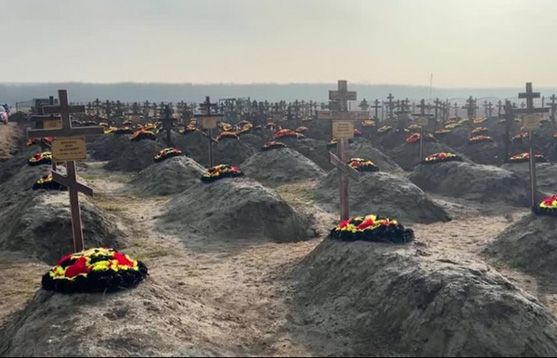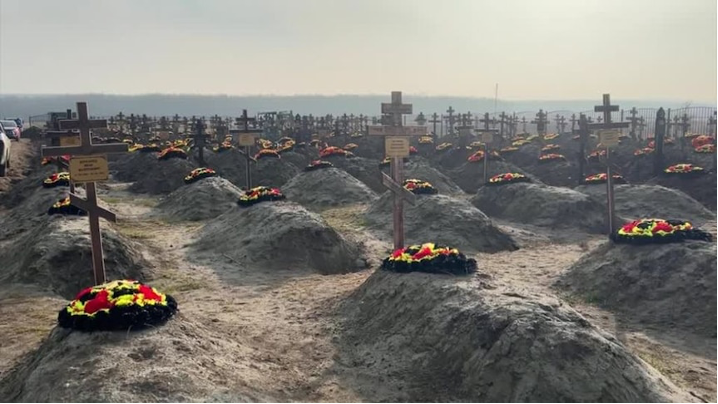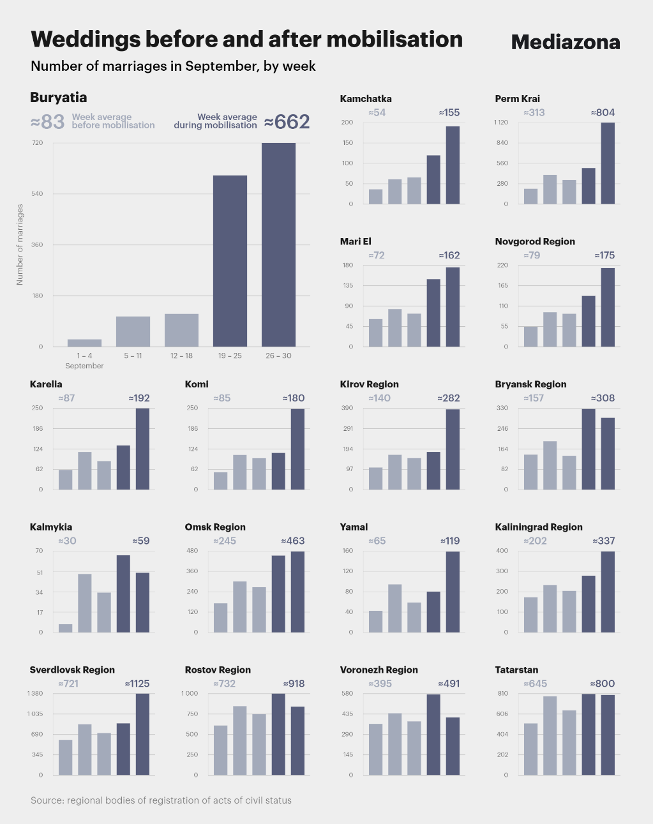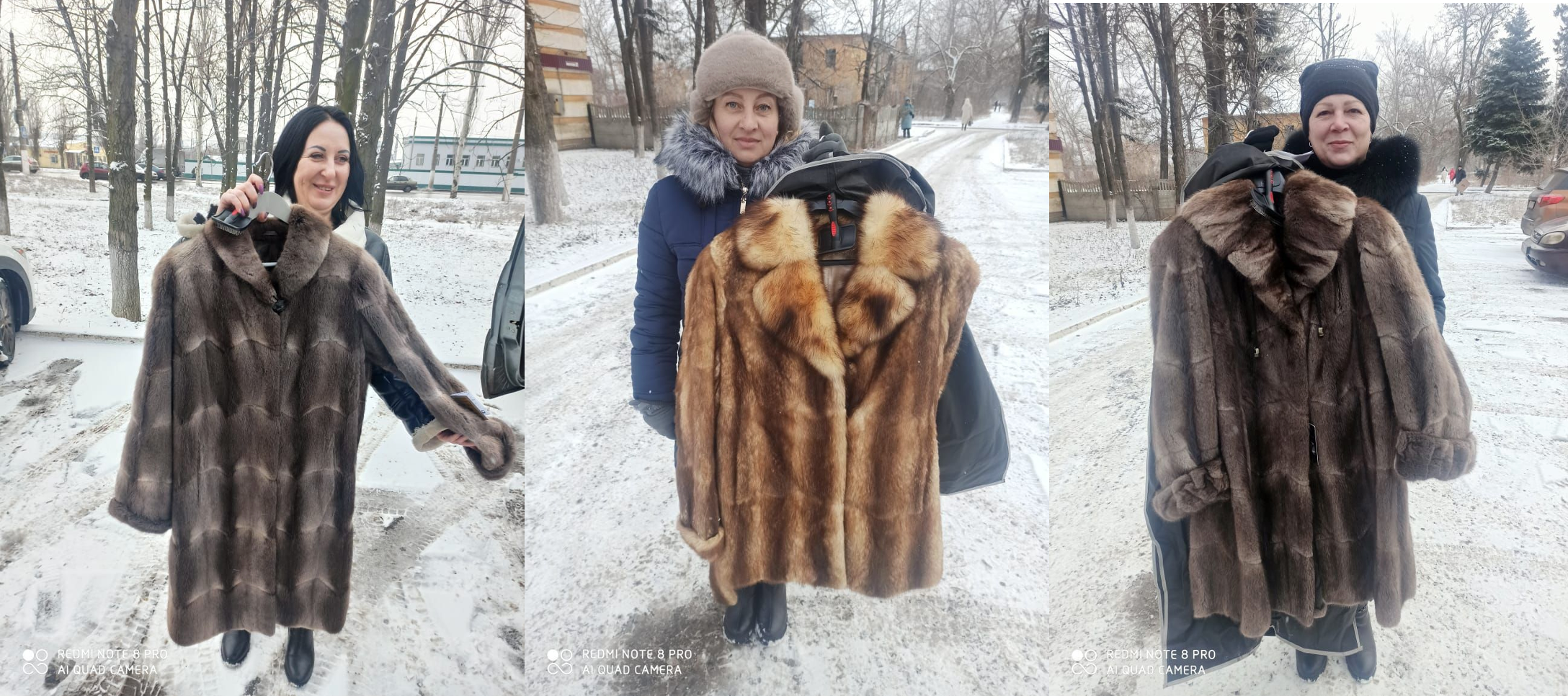Article
Impact of the death toll in Ukraine on the social situation in Russia

It has been over a year since Russia invaded Ukraine in late February 2022. From Putin’s planned blitzkrieg, it has turned into a conflict of attrition for both sides. The exact number of casualties and deaths is difficult to estimate with neither side publishing transparent accounts. There are many conflicting open-source estimates of the death toll on both sides with sources using a variety of different inputs and calculation methods in their estimates. However, almost all western sources have estimated that the number of Ukrainian casualties is lower than those suffered by the Russian armed forces. The effect that casualties have on either sides capability and willingness to fight is also impacted by differences in the size of their respective populations, choice of operational tactics, availability of hardware resources, and how well-known actual casualty numbers are in that countries' information space, and other factors.
On March 14, the General Staff of the Armed Forces of Ukraine announced that more than 160,000 Russian troops had been “liquidated” since the beginning of the war. It is unclear whether the term “liquidated” refers to those injured or killed. Given that Russia allegedly started the war with 190,000 troops in occupied Ukraine and near Ukraine [1], if the Ukranian “liquidation” figured do represent deaths then this would mean that 84% of the initial force has now been “liquidated”.
The Center for Strategic and International Studies (CSIS), an American thinktank based in Washington, estimates that between February 2022 and February 2023, approximately 60,000 to 70,000 Russian combat fatalities occurred in Ukraine. These estimates include regular Russian soldiers, Rosgvardiya (National Guard), Federal Security Service, Federal Guard Service; fighters from pro-Russian militias, such as the Donetsk and Luhansk People’s Militias; and contractors from private military companies such as WagnerPMC. In total, Russia lost approximately 200,000 to 250,000 people—wounded, killed, and missing—in the first year of the war.[2]
The BBC also verified the names of fallen Russian professional soldiers, mobilized Russian men, dead convicts and the "people's militia" of Donetsk and Luhansk up to March 2023. Considering only publicly available data, they found that the cumulative losses of fighters on the Russian side exceeded 47,000. Thus, Russia's total loss (that is, the number of people disabled or missing due to injury or death) could be at least 157,500 people.[3]
On January 22, General Eirik Kristoffersen, Chief of the Norwegian Defence Forces, said it was estimated that 180,000 Russian soldiers had been killed and wounded on the Russian side, and 100,000 on the Ukrainian side.[4] Later General Kristoffersen said through his spokesman in an email to The New York Times that there is “much uncertainty regarding these numbers, as no one at the moment is able to give a good overview. They could be either lower or even higher".[5]
A few days after General Kristoffersen’s comments, Senior US officials stated that that they believed the Russian death toll was close to 200,000. If accurate, the figure is quite high and would make the death toll from only 11 months of conflict eight times higher than American casualties suffered in two decades of war in Afghanistan.[5]
Russia has compensated the high death toll by sending more regular troops to Ukraine sourced from units all over Russia. This was supported by a partial mobilisation carried out during October 2022 which enlisted 318,000 people.[6] Moreover, despite the official end of the mobilisation, Russia has continued to recruit soldiers covertly (for further details see SensusQ article - The second Russian mobilisation).[7] The head of Russia’s largest Private Millitary Company – Wagner Group, Yevgeny Prigozhin, also recruited some 50,000 convicts from Russian prisons, 80% of whom have already been killed or wounded, deserted, or surrendered.[8]

Kyrylo Budanov, head of Ukraine's Main Military Intelligence Directorate (GUR) announced on 31 January that 326,000 Russian troops were currently fighting in Ukraine.[9] Ukrainian Defense Minister Oleksii Reznikov claimed on February 1 that the number of Russian troops mobilized was much higher than the Kremlin's official figure of 300,000. Reznikov stated that the Kremlin had mobilized 500,000 Russian troops.[10]
According to these numbers, if even the highest Russian casualty estimates are correct, the number of Russian troops in Ukraine has likely not decreased but increased since the start of the war.
Impact of the invasion on the wellbeing of Russians
In early March 2022, Vladimir Putin announced compensations for the families of Russian soldiers killed or injured in Ukraine. "All family members of our servicemen killed during the special military operation in Ukraine will be paid statutory insurance coverage and a lump sum payment, that's 7,421,000 rubles. Also, a monthly compensation will be paid to every family member of the dead. But, in addition, I consider it necessary to establish an additional payment to each family of the deceased serviceman of the Ministry of Defence, military personnel and employees of other law enforcement agencies participating in the operation, in the amount of 5 million rubles," said Putin.[11] In total, this would be 12,421,000 rubles (around 150,000 euros) and a monthly allowance. In Russia, a person typically earns about 1,240,000 rubles a year. The average salary ranges from 315,000 RUB (lowest average) to 5,560,000 RUB (highest average) per year. [12] Therefore, compensation for a slain family member would be in average 10 years’ wages and even 40 years’ wages for the poorest families.
On March 13, The UK Ministry of Defence announced that the impact of Russian casualties varies dramatically across Russia’s regions. In proportion to the size of their population, the richest cities of Moscow and St Petersburg have been left relatively unscathed and this is especially true for the families of the country’s elite. On the other hand, in many eastern regions the percentage of deaths per capita is likely 30+ times higher than in Moscow. In places, ethnic minorities are most impacted; in Astrakhan some 75% of casualties are from Kazakh and Tatar minorities.[13] The disproportional impact on minorities is known within these communities, a video appeared in January 2023 in which Tuvan women ask not to send their sons to Ukraine, because there are few Tuvans left. In January, Tuva was ranked among the five regions with the highest losses in Ukraine, with 368 killed Tuvans officially confirmed.[14] What the women of Tuva did not know is that, according to recruitment statistics, Putin’s mobilisation is primarily aimed at minority ethnic groups.
Paradoxically, the war, or rather the death of close relatives and subsequent compensation, has become the main driving factor in the income growth of poorer Russians. The increase in social spending by the state caused a sharp increase in the incomes of the poorest 10% of the population. The growth in government spending on compensations linked to the war caused the income of poor Russians to overtake inflation twice in 2022. The increase in military social payments has pushed many of Russia’s poorest above the official poverty line. According to Rosstat’s data for the third quarter of 2022, the number of poor people decreased by 700,000 compared to the same period last year and by 2.3 million compared to the second quarter of 2022.[15]
After Putin announced the mobilization, nearly every region across the Russia saw a spike in marriages. In most regions, mobilized soldiers were allowed to marry the same day that they filed papers with their partners. Some regions arranged buses to transport soldiers and their fiancés from assembly bases to the nearest marriage registration office, while others arranged temporary wedding halls at the bases themselves.[16] The number of marriages skyrocketed because in the worst-case scenario only married spouses were eligible for benefits.
Interestingly, Mediazona, comparing the data of the regional registry offices with the data of the Federal State Statistics Service and the latest census, found that at least 492,000 people had already mobilized in Russia by mid-October. The percentage of mobilized varied significantly from region to region. (Figure 2) According to the “excess marriage” data, the highest mobilisation rate was in eastern Russia: Amur Oblast, Zabaykalsky Krai, Jewish Autonomous Region, Khabarovsk Krai, and the Republic of Buryatia. [17]

The Russian invasion of Ukraine eases domestic violence
Alcoholism has been a problem throughout the Russia's history because drinking has been a pervasive and socially acceptable behaviour in its society. Alcoholism in Russia, according to some authors, has acquired the character of a national disaster. While alcohol consumption per capita in several Western countries is not lower than in Russia, the "drunk" crime rate in Russia is among the highest. [18] [19]
Domestic violence is also a serious problem in Russia. According to RIA Novosti, as many as 36,000 women and 26,000 children faced daily abuse at home in 2013. Every year 12,000 women are killed because of domestic violence, which is one woman for every 40 minutes. Furthermore, 60-70% of victims do not seek assistance or support and 97% of cases never end up in court. [20] According to human rights activist Alena Popova, out of 77.1 million Russian women aged 16 and older, 18% have suffered verbal violence, 6% physical and 1% sexual violence in 2016. [21] According to the study, families who have experienced domestic violence are also often victims of poverty. [22]
The tradition of beating a life partner appeared in Rus' after the adoption of Christianity. Now it seems surprising, but in the days of paganism, a woman was an equal member of society. Along with baptism, Rus' also adopted a new morality, which provided for the “salvation of the soul” of a woman. How? Naturally, regular beatings. Many clergymen, deacons and priests, perceived women as the root of all evil, believed that from birth there is a devilish principle in her, which needs to be “pacified” from time to time, or not allowed to come out through “preventive” beatings. In other words, if a man beats his wife, it means that he takes care of her, expresses his love and care. [23]
“If he beats you, it means he loves you,” as one famous Russian saying has it. According to some studies, the phrase first appeared in the late 16th century, after a book called “Domostroy” (“Household”) was published. This book, a guide for families, carried a strong Orthodox Christian message. It outlined women’s obedience as the key to a strong, lasting family, and described corporal punishment — for women and children — as a “mere blessing” that can help “avoid death of the soul.” The Domostroy mentality was rejected for a short period in post-revolutionary Soviet Russia in favor of equality. But it made a triumphant return during later in the Soviet period, although without previous religious undertones, before embedding in the social norms of 21st century Russia. Today, police stations rarely take reports of familial battery seriously — they often dismiss victims’ complaints, citing the problem as one’s “internal family matter.” Some say that they can only intervene when a murder is committed. [24]
Ultraconservative Federation Council senator Yelena Mizulina introduced a new bill to the State Duma in July 2016 that proposed the decriminalization of battery within families. “Battery carried out toward family members should be an administrative offense,” Mizulina said. “You don’t want people to be imprisoned for two years and labeled a criminal for the rest of their lives for a slap.” Traditional family values crusaders supported Mizulina’s attempts to undo the amendment. The Russian Orthodox Church issued a statement saying that “if reasonable and carried out with love, corporal punishment is an essential right given to parents by God.” [24]
It is worth noting that the Russian invasion may have inadvertently led to the removal of abusive partners for some families and women experiencing domestic violence. Due to the high death toll and prevalence of domestic violence in Russia, it is possible that many violent men were mobilized to Ukraine and may have perished there. Given that domestic violence occurs more frequently among the poor, and those mobilized were primarily from the poorest segments of Russian society, it is plausible that some families see it as being freed from a burden. Another important fact that adds to the perceived positive impact of the invasion is that these families receive a one-time payment of 10-40 years’ wages and a permanent monthly allowance as compensation.
Additional benefits for the families of the deceased
A few different initiatives have been taken in Russia to prize the widows of fallen Russian soldiers and compensate them for the loss of their spouses. For example, the Bashkirian authorities support the families of fallen soldiers by providing one-off material assistance in the amount of 2 million rubles in equal shares to each family member. [25]

On 2nd in February, it was reported that businessman Boryak Aleksandr Vasilyevich donated 21 fur coats to the widows of fallen Russian soldiers. [26] This turned into a controversial case, as the coats were initially distributed to 13 women who cordially thanked organizers for such "unexpected" help in a propaganda video (https://vk.com/video280438963_456239396) that was taken. It is alleged that after the video was recorded, the fur coats were taken off. Initially, the women were told that the issued coats were of poor quality, and they were allowed to issue new ones. But after numerous phone calls, some of the women were told it was a mistake and the fur coats were meant for other widows. [27] However, 21 photographs of the widows and mothers of fallen Russian soldiers were published on the Telegram channel @donbass_scriptor between 6.-26. February, to whom coats were distributed and most of them were still the same persons as those on the original video. [28] (Figure 3)
A project called “Wives of Heroes” was born in Samara Oblast, where the widows of fallen soldiers put on their husband’s parade tunics with decorations and a photo session was taken and published. (Figure 4) The project was allegedly supported by Vladimir Putin himself and has since spread across Russia. According to the widows who participated in this project, they consider it important to show the whole society and not to let it be forgotten that their husbands are heroes, and they are widows of fallen heroes. [29] Certainly, the status of a fallen hero’s widow in Russian society is higher than that of an ordinary widow and this is likely to help Russian women to overcome grief as well.
In July 2022, Russian TV broadcast an interview with a grieving mother and father who proudly bought a new car Lada with "coffin money", which is officially “a one-off allowance for the family of the deceased”, given to them after their son was killed in Ukraine. The Lada was bought because their son had dreamt of such a white car. The parents said their son was a brave man who “had fought against fascism, just like his grandfathers and great-grandfathers.” Anyway, the parents thought they could live in peace with the Ukrainians “once they have destroyed those Nazis there.” [30] Watching this interview, there is no doubt that the mother and father are in deep grief, but on the other hand, they accept their son’s death as an inevitability and necessity that had to happen in order to save the motherland Russia from “the evil Nazis” and “Western Fascists”.
The impact of casualties on Russian society
Whether the death toll on the Russian side is “just” 60,000 or over 200,000, this figure certainly seems enormous at first glance. For a small country such as Estonia (which is SensusQ's country of origin), this would roughly be between 5% and 15% of the population. However, Russia is gargantuan compared to Estonia and the death toll is only about 0.1% of Russia's population. In Estonia’s context, this figure would be about twice the number of fatalities in the cruise ferry “MS Estonia” disaster in 1994. However, it is likely still difficult to compare, as those who lost their loved one in the accident consider the death of "MS Estonia" more disastrous than those who know about it merely from the news. In addition, most Russian soldiers, and thus also the casualties, are from minority ethnic groups living in Russia, from poorer families, from penal colonies, and on top of that their families have been compensated relatively well for the loss of their sons, fathers, and spouses. Russian propaganda has also brainwashed citizens, and therefore the families of the victims quite often take the loss of their men as an inevitability and necessity that must have happened “to protect Russia from the Nazis and Fascists”. Therefore, it is unlikely that the increase in the death toll will deter President Putin's war aims. He has no political opposition at home and has portrayed the war as a struggle the country faced in World War II, when more than 8 million Soviet soldiers died. Putin probably can sustain hundreds of thousands of casualties in Ukraine, if he manages to keep them within the same social groups as up to this day. While the increase in casualties may reduce his political support somewhat, it is unlikely to threaten his position.

Download full article:
REFERENCES
[1] Citing U.S. Intelligence, Biden Says Putin Has Decided to Invade Ukraine. Feb 2022. [Online] nytimes.com/live/2022/02/18/world/russia-ukraine-biden-putin
[2] Ukrainian Innovation in a War of Attrition. Feb 2023. [Online] csis.org/analysis/ukrainian-innovation-war-attrition
[3] Forsvarssjefen: Så mange liv har gått tapt i Ukraina-krigen. Jan 2023. [Online] tv2.no/nyheter/utenriks/forsvarssjefen-sa-mange-liv-har-gatt-tapt-i-ukraina-krigen/15447680/
[4] Потери России за 13 месяцев войны в Украине: скачок смертей заключенных. Mar 2023. [Online] bbc.com/russian/features-64984414
[5] Soaring Death Toll Gives Grim Insight Into Russian Tactics. Feb 2023. [Online] nytimes.com/2023/02/02/us/politics/ukraine-russia-casualties.html
[6] Путин сообщил, что 49 тыс. мобилизованных находятся уже в зоне боевых действий. Nov 2022. [Online] interfax.ru/russia/871090
[7] The second Russian mobilisation. Jan 2023. [Online] sensusq.com/blog/970d5310-d678-4309-993a-47cd5d075442
[8] «Русь сидящая»: из 50 тысяч заключенных, завербованных ЧВК Вагнера, на фронте остались только 10 тысяч. Остальные либо погибли, либо дезертировали. Jan 2022. [Online] meduza.io/news/2023/01/23/rus-sidyaschaya-iz-50-tysyach-zaklyuchennyh-zaverbovannyh-chvk-vagnera-na-fronte-ostalis-tolko-10-tysyach-ostalnye-libo-pogibli-libo-dezertirovali
[9] Ukraine intel chief predicted Russia’s war. He says Crimea will be retaken. Jan 2023. [Online] washingtonpost.com/world/2023/01/31/kyrylo-budanov-ukraine-intelligence-boss-interview/
[10] Le ministre de la Défense ukrainien pense que la Russie va "tenter une offensive" vers le 24 février. Feb 2023. [Online] bfmtv.com/international/europe/ukraine/le-ministre-de-la-defense-ukrainien-pense-que-la-russie-va-tenter-une-offensive-vers-le-24-fevrier_AV-202302010716.html
[11] Семьи погибших на Украине российских военных получат дополнительно по 5 млн рублей. Mar 2022. [Online] tass.ru/armiya-i-opk/13955625
[12] Average Salary in Russia 2023. [Online] salaryexplorer.com/salary-survey.php?loc=179&loctype=1
[13] Twitter: UK Ministry of Defence. Mar 2023. [Online] twitter.com/DefenceHQ/status/1634801825286172673
[14] VK: Говорит НеМосква. Jan 2023. [Online] vk.com/wall-216917715_960
[15] Putin Buys Off the Poor, Writes Off Middle Class With War Budget. Jan 2023. [Online] bloomberg.com/news/articles/2023-01-13/putin-buys-off-the-poor-writes-off-middle-class-with-war-budget?srnd=premium-europe&leadSource=uverify%20wall#xj4y7vzkg
[16] Till Death Do Us Part: Sharp Spike In Marriages As Russian Men Are Mobilized For Ukraine War. Nov 2022. [Online] rferl.org/a/russia-war-marriages-boom/32110926.html
[17] Давай поженимся. Рост числа свадеб показывает, что к середине октября в России мобилизовали как минимум 492 тысячи человек. Oct 2022. [Online] zona.media/article/2022/10/24/wedding-season
[18] Г. Г. Заиграев: Алкоголизм и пьянство в России. Пути выхода из кризисной ситуации. 2009. [Online] isras.ru/files/File/Socis/2009-08/Zaigraev.pdf
[19] WHO: Interpersonal Violence and Alcohol in the Russian Federation. 2006. [Online] euro.who.int/__data/assets/pdf_file/0011/98804/E88757.pdf
[20] Инфографика. Домашнее насилие в России. Jan 2013. [Online] sn.ria.ru/20130129/920211298.html
[21] Сергей Медведев: #ЯнеБоюсьСказать. Jul 2016. [Online] svoboda.org/a/27858740.html
[22] Deborah Satyanathan and Anna Pollack: Domestic Violence and Poverty. Jul 2015. [Online] purdue.edu/hhs/hdfs/fii/wp-content/uploads/2015/07/s_mifis04c05.pdf
[23] Откуда появилась поговорка «бьет — значит любит» и почему это не так? [Online] interesnoznat.com/interesno/otkuda-poyavilas-pogovorka-bet-znachit-lyubit-i-pochemu-eto-ne-tak.html
[24] “If He Beats You, It Means He Loves You” Aug 2016. [Online] themoscowtimes.com/2016/08/05/if-he-beats-you-it-means-he-loves-you-a54866
[25] Власти Башкирии рассказали, сколько денег потратили на поддержку мобилизованных и добровольцев. Mar 2023. [Online] ufa1.ru/text/politics/2023/03/03/72106373/?utm_source=telegram&%3Butm_medium=messenger&%3Butm_campaign=ufa1
[26] Помощь Донбассу (Евгений Скрипник "Прапор") Feb 2023. [Online] t.me/donbass_skripnik/6596
[27] Вдовам погибших военных в "ДНР" вручили шубы и сняли об этом пропагандистский ролик – а после съемок у нескольких женщин шубы забрали. Feb 2023. [Online] currenttime.tv/a/dnr-u-zhenschin-zabrali-shuby/32263738.html
[28] Помощь Донбассу (Евгений Скрипник "Прапор") Feb 2023. [Online] t.me/donbass_skripnik/6694; t.me/donbass_skripnik/6718; t.me/donbass_skripnik/6742; t.me/donbass_skripnik/6758; t.me/donbass_skripnik/6793; t.me/donbass_skripnik/6824; t.me/donbass_skripnik/6843; t.me/donbass_skripnik/6849; t.me/donbass_skripnik/6884; t.me/donbass_skripnik/6915; t.me/donbass_skripnik/6942; t.me/donbass_skripnik/6964; t.me/donbass_skripnik/6991; t.me/donbass_skripnik/7001; t.me/donbass_skripnik/7017; t.me/donbass_skripnik/7034; t.me/donbass_skripnik/7066; t.me/donbass_skripnik/7107; t.me/donbass_skripnik/7127; t.me/donbass_skripnik/7155; t.me/donbass_skripnik/7182
[29] Супруги российских военнослужащих стали моделями фотопроекта «Жёны героев». Nov 2022. [Online] gtrkoka.ru/news/2022/11/14/suprugi-rossijskih-voennosluzhashhih-stali-modeljami-fotoproekta-zhjony-geroev.html
[30] Russian video depicts parents who lost son to war showing off the Lada they bought with 'coffin money'. Jul 2022. [Online] telegraph.co.uk/world-news/2022/07/19/russian-video-depicts-parents-who-lost-son-war-showing-lada/